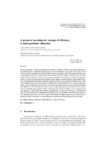Mostrar o rexistro simple do ítem
A means of assessing the wastage of efficiency in undergraduate education
| dc.contributor.author | Fernández-Castro, Alejandro M. | |
| dc.contributor.author | Fernández-Castro, Belén | |
| dc.date.accessioned | 2024-04-09T11:45:57Z | |
| dc.date.issued | 2011 | |
| dc.identifier.citation | Fernández-Castro, A.M. & Fernández-Castro, B. (2011). A means of assessing the wastage of efficiency in undergraduate education. Presupuesto y Gasto Público,65 (4/11), 63-77 | es_ES |
| dc.identifier.issn | 0210-5977 | |
| dc.identifier.uri | http://hdl.handle.net/2183/36109 | |
| dc.description.abstract | [Abstract]: The aim of this paper is to propose an indicator that measures the wastage of efficiency in the undergraduate university educational process. Taking the indicator proposed by Rao and Tikkiwal (1966), and its recent version in Ortiz (2003) as the point of departure, a modification of this indicator is suggested to make it fully operational in the context of undergraduate education. The Rao-Tikkiwal indicator estimates the total wastage of efficiency at two levels: the wastage of internal efficiency, which takes into account the proportion of students who complete the programme (course or cycle) and the time spent in the programme; and the wastage of external efficiency, which measures the validity of the learning and skills acquired during the programme (course or cycle) through the graduate students’ ability to successfully enter the next level of training or the labour market. When this indicator is used to measure external efficiency, the loss of efficiency observed is less, the greater the time lapse between a given cohort and the analysis. When applied to the case of undergraduate education, given a single output (graduates), the greater the time lapse, the greater the probability that the graduate will have found employment suited to his training. However, efficiency levels vary depending on when the individual graduates find employment. In other words, the degree of efficiency in the case of a cohort of graduates who find employment within one year after graduation should not be equal to that of a cohort that takes longer to do so. In order to overcome this limitation, this paper presents a solution to the problem of assessing the effect of time lapse on external efficiency by proposing an indicator that takes this into account. | es_ES |
| dc.language.iso | eng | es_ES |
| dc.publisher | Instituto de Estudios Fiscales | es_ES |
| dc.subject | Education | es_ES |
| dc.subject | Internal and external efficiency | es_ES |
| dc.subject | Wastage of efficiency | es_ES |
| dc.title | A means of assessing the wastage of efficiency in undergraduate education | es_ES |
| dc.type | info:eu-repo/semantics/article | es_ES |
| dc.rights.access | info:eu-repo/semantics/embargoedAccess | es_ES |
| dc.date.embargoEndDate | 9999-99-99 | es_ES |
| dc.date.embargoLift | 10007-06-07 | |
| UDC.journalTitle | Presupuesto y Gasto Público | es_ES |
| UDC.volume | 65 | es_ES |
| UDC.issue | 4/11 | es_ES |
| UDC.startPage | 63 | es_ES |
| UDC.endPage | 77 | es_ES |
Ficheiros no ítem
Este ítem aparece na(s) seguinte(s) colección(s)
-
GI-GREFIN - Artigos [70]






